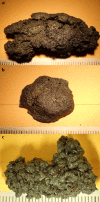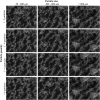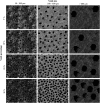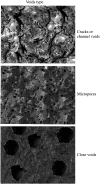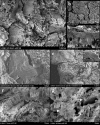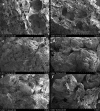A methodological approach to the study of archaeological cereal meals: a case study at Çatalhöyük East (Turkey) - PubMed (original) (raw)
A methodological approach to the study of archaeological cereal meals: a case study at Çatalhöyük East (Turkey)
Lara González Carretero et al. Veg Hist Archaeobot. 2017.
Abstract
This paper presents an integrated methodology for the analysis of archaeological remains of cereal meals, based on scanning electronic microscopic analyses of microstructures of charred food fragments from Neolithic Çatalhöyük (Turkey). The remains of cereal foods as 'bread-like' or 'porridge-like' small charred lumps of various amalgamated plant materials are frequently recovered from Neolithic and later archaeological sites in southwest Asia and Europe. Cereal food remains have recently attracted interest because the identification of their plant contents, the forms of food that they represent and the methods used in their creation can provide unique information about ancient culinary traditions and routine food processing, preparation and cooking techniques. Here, we focus on three methodological aspects: (1) the analysis of their composition; (2) the analysis of their microstructure to determine preparation and cooking processes; (3) the comparison with experimental reference materials. Preliminary results are presented on the botanical composition and cooking processes represented by the charred cereal preparations found at Neolithic Çatalhöyük (Turkey), for example cereals processed into bread, dough and/or porridge.
Keywords: Food remains; Near East; Neolithic; Palaeoethnobotany; Parenchyma.
Figures
Fig. 1
Fragments of processed plant food from Çatalhöyük East: a Fl.10661; b Fl.11860; c Fl.10721; d Fl.9875
Fig. 2
Experimental flour types: fine (<0.5 mm), coarse grain or fine bulgur (>0.5 mm) and coarse bulgur (>1 mm) mixed with cracked grain and flakes
Fig. 3
Fragments of experimentally prepared cereal foods, charred at 300 °C for 3 h: a no water treated wheat flat bread; b no water treated wheat dough, c no water treated wheat porridge
Fig. 4
Attribute set A: particles. Estimation chart based on size and quantity of visible plant particles in the matrix
Fig. 5
Attribute set B: voids. Estimation chart based on size and percentage of voids (air bubbles) in the matrix
Fig. 6
Attribute set C: type of voids. Estimation chart based on shape of voids (air bubbles) in the matrix
Fig. 7
SEM micrographs showing plant components in food fragments: a Fl.9822, Hordeum grain and bran fragments embedded in food matrix; b Fl.7860, remains of aleurone layer from food fragment; c Fl.10742, unicellular aleurone layer from food fragment; d Fl.6939, fragment of cf. Triticum bran transverse cells; e Fl. 3099, Descurainia sophia seed embedded in food matrix and detail of seed coat; f Fl.11137, remains of visible pulse palisade cells layer; g Fl.11240, remains of pulse palisade cells layer and cereal bran, marked by arrows, mixed together in food matrix
Fig. 8
SEM micrographs showing different food matrices identified from processed foods at Çatalhöyük East: a, b Matrix type 1; c, d Matrix type 2; e, f Matrix type 3; g, h Matrix type 4
Fig. 9
SEM micrographs showing correlation between matrices from archaeological (left) and experimentally prepared food samples (right) : a, b correlation between Matrix type 1 and experimental doughs; c, d correlation between Matrix type 3 and experimental flat breads; e, f correlation between Matrix type 4 and experimental porridges
Similar articles
- Mashes to Mashes, Crust to Crust. Presenting a novel microstructural marker for malting in the archaeological record.
Heiss AG, Azorín MB, Antolín F, Kubiak-Martens L, Marinova E, Arendt EK, Biliaderis CG, Kretschmer H, Lazaridou A, Stika HP, Zarnkow M, Baba M, Bleicher N, Ciałowicz KM, Chłodnicki M, Matuschik I, Schlichtherle H, Valamoti SM. Heiss AG, et al. PLoS One. 2020 May 7;15(5):e0231696. doi: 10.1371/journal.pone.0231696. eCollection 2020. PLoS One. 2020. PMID: 32379784 Free PMC article. - State of the (t)art. Analytical approaches in the investigation of components and production traits of archaeological bread-like objects, applied to two finds from the Neolithic lakeshore settlement Parkhaus Opéra (Zürich, Switzerland).
Heiss AG, Antolín F, Bleicher N, Harb C, Jacomet S, Kühn M, Marinova E, Stika HP, Valamoti SM. Heiss AG, et al. PLoS One. 2017 Aug 3;12(8):e0182401. doi: 10.1371/journal.pone.0182401. eCollection 2017. PLoS One. 2017. PMID: 28771539 Free PMC article. - Cereal processing at Early Neolithic Göbekli Tepe, southeastern Turkey.
Dietrich L, Meister J, Dietrich O, Notroff J, Kiep J, Heeb J, Beuger A, Schütt B. Dietrich L, et al. PLoS One. 2019 May 1;14(5):e0215214. doi: 10.1371/journal.pone.0215214. eCollection 2019. PLoS One. 2019. PMID: 31042741 Free PMC article. - Lignan Content in Cereals, Buckwheat and Derived Foods.
Durazzo A, Zaccaria M, Polito A, Maiani G, Carcea M. Durazzo A, et al. Foods. 2013 Feb 7;2(1):53-63. doi: 10.3390/foods2010053. Foods. 2013. PMID: 28239096 Free PMC article. Review. - Effects of different cooking technologies on biopolymers modifications of cereal-based foods: Impact on nutritional and quality characteristics review.
De Pilli T, Alessandrino O. De Pilli T, et al. Crit Rev Food Sci Nutr. 2020;60(4):556-565. doi: 10.1080/10408398.2018.1544884. Epub 2018 Dec 30. Crit Rev Food Sci Nutr. 2020. PMID: 30596251 Review.
Cited by
- Unveiling the culinary tradition of 'focaccia' in Late Neolithic Mesopotamia by way of the integration of use-wear, phytolith & organic-residue analyses.
Taranto S, Barcons AB, Portillo M, Le Miere M, Gomèz AB, Molist M, Lemorini C. Taranto S, et al. Sci Rep. 2024 Nov 5;14(1):26805. doi: 10.1038/s41598-024-78019-9. Sci Rep. 2024. PMID: 39500990 Free PMC article. - Investigating grandmothers' cooking: A multidisciplinary approach to foodways on an archaeological dump in Lower Casamance, Senegal.
Debels P, Drieu L, Chiquet P, Studer J, Malergue A, Martignac L, Champion L, Garnier A, Fichet V, Sall M, Regert M, Mayor A. Debels P, et al. PLoS One. 2024 May 29;19(5):e0295794. doi: 10.1371/journal.pone.0295794. eCollection 2024. PLoS One. 2024. PMID: 38809808 Free PMC article. - The impact of farming on prehistoric culinary practices throughout Northern Europe.
Lucquin A, Robson HK, Oras E, Lundy J, Moretti G, González Carretero L, Dekker J, Demirci Ö, Dolbunova E, McLaughlin TR, Piezonka H, Talbot HM, Adamczak K, Czekaj-Zastawny A, Groß D, Gumiński W, Hartz S, Kabaciński J, Koivisto S, Linge TE, Meyer AK, Mökkönen T, Philippsen B, Piličiauskas G, Visocka V, Kriiska A, Raemaekers D, Meadows J, Heron C, Craig OE. Lucquin A, et al. Proc Natl Acad Sci U S A. 2023 Oct 24;120(43):e2310138120. doi: 10.1073/pnas.2310138120. Epub 2023 Oct 16. Proc Natl Acad Sci U S A. 2023. PMID: 37844237 Free PMC article. - Epipalaeolithic animal tending to Neolithic herding at Abu Hureyra, Syria (12,800-7,800 calBP): Deciphering dung spherulites.
Smith A, Oechsner A, Rowley-Conwy P, Moore AMT. Smith A, et al. PLoS One. 2022 Sep 14;17(9):e0272947. doi: 10.1371/journal.pone.0272947. eCollection 2022. PLoS One. 2022. PMID: 36103475 Free PMC article. - Crops on the Rocks: Production, Processing, and Storage at the Early Medieval Site of Senhora Do Barrocal (Municipality of Sátão, Central Portugal).
Seabra L, Tente C, Vaz FC, Oliveira C, González Carretero L, Tereso JP. Seabra L, et al. Plants (Basel). 2022 Feb 9;11(4):471. doi: 10.3390/plants11040471. Plants (Basel). 2022. PMID: 35214803 Free PMC article.
References
- Akkermans P, Schwartz G. The Archaeology of Syria: From complex hunter-gatherers to early urban societies (c.16,000-300 BC) Cambridge: Cambridge University Press; 2003.
- Akkermans P, Cappers R, Cavallo C, Nieuwenhuyse O, Nilhamn B, Otte N. Investigating the early pottery Neolithic of northern Syria: new evidence from Tell Sabi Abyad. Am J Archaeol. 2006;110:123–156. doi: 10.3764/aja.110.1.123. - DOI
- Antolin F, Alonso N, Berihuete M, Brombacher C, Chrondrou D, Ertug F, Garcia-Granero JJ, Gonzalez Carretero L, Hamon C, Heiss AG, Jacomet S, Naranjo Y, Perego R, Procopiou H, Steiner B, Valamoti S, Wojtczak D, Wollstonecroft M. Grütze, Bulgur, Mehl und Griess. Jb Archäol Schweiz. 2016;99:143–151.
- Atalay S, Hastorf C. Food, meals, and daily activities: food habitus at Neolithic Çatalhöyük. Am Antiq. 2006;71:283–319. doi: 10.2307/40035906. - DOI
- Bayliss A, Brock F, Farid S, Hodder I, Southon J, Taylor RE. Getting to the bottom of it all: a Bayesian approach to dating the start of Çatalhöyük. J World Prehist. 2015;28:1–26. doi: 10.1007/s10963-015-9083-7. - DOI
LinkOut - more resources
Full Text Sources
Other Literature Sources


